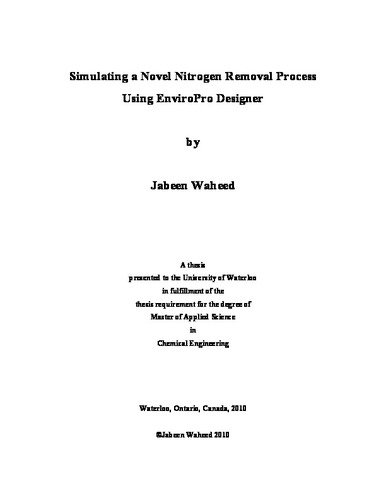| dc.description.abstract | Ammonia removal is an important problem that Canadian municipalities are encountering in their wastewater treatment systems due to ammonia’s adverse environmental effects and its increasingly stringent discharge standards.
Nitrogen compounds are generally removed from wastewater by a combination of nitrification and denitrification. In full nitrification, ammonia is first biologically oxidized to nitrite, which is then oxidized to nitrate by nitrite-oxidizing bacteria. In denitrification, the resulting nitrate has to be first reduced to nitrite in order to be converted to nitrous oxide, then nitric oxide, and finally to nitrogen gas. Since, nitrite is an intermediary compound in both nitrification and denitrification, it may be more efficient to produce a partial nitrification up to nitrite and then denitrification starting from this nitrite.
In this research, EnviroPro Designer was
used to simulate, optimize and compare process models for both full nitrification and partial nitrification. The Full System model simulates the traditional full nitrification followed by denitrification. Partial System-1 model simulates the partial nitrification process followed by denitrification directly from nitrite. Partial System-1 significantly reduced the ammonia and domestic waste concentrations in the effluent while achieving 1.5 times faster denitrification rates and utilizing 33% less oxygen. Partial System-1 was further optimized to develop a novel nitrogen removal process, Partial System-3, which incorporated an additional third anoxic stage while the aerobic stage in sludge treatment was removed. Partial System-3 successfully reduced the ammonia and nitrite concentrations in the effluent to values well within the current guidelines while consuming 50% less oxygen than the Full System, which reflected favorably on utility savings. It also showed 2 times faster denitrification rates, and displayed superior domestic waste consumption. Furthermore, the capital and operational costs were less than other nitrogen removal systems investigated in this thesis. The novel Partial System-3 appears to be the best option for removal of nitrogen from medium to high strength wastewater, and further experimental research is required to confirm the kinetic and yield constants assumed in the simulations. | en |

